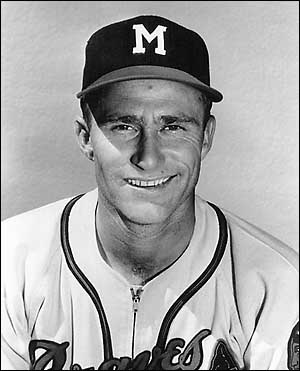The Pride of Nitro
Baseball Star Lew Burdette
by David Driver
Behind the small house on Third Avenue is a hill where the family raised a few chickens, pigs, and cows on a nearly one-acre plot.
When the chores were done the two boys would climb that small hill to play, and from their vantage point they could look down toward their parents' pre-fabricated home built near the time of World War I.

Lew in the big leagues. 1955 photo courtesy of the Charleston Gazette.
"I didn't know what I wanted to be," Burdette told Sportmagazine in 1957. "I never figured much on being a ballplayer."
On many occasions one of the boys would toss rocks down the hill, as he aimed for the tree behind the house where they were born. More times than not he hit his mark.
This was the setting — the small town of Nitro in the 1930's — that propelled one of the greatest baseball players in the history of the state. It was there, in the World War I boom town northwest of Charleston along the Kanawha River, that Selva Lewis Burdette, Jr., was born on November 22, 1926, of French-German descent. He would grow up to sign his name "Lou," but his nickname was "Lew."
From his rock-throwing days at 28-34 Third Avenue to his 18 seasons as a pitcher in the major leagues, Lew Burdette more times than not was on the money with is offerings. Most of Burdette's success was with the Milwaukee Braves, and he was the toast of baseball after the 1957 World Series.
That October he started, finished, and won three games for Milwaukee against the hated New York Yankees, a team that had traded him late in the 1950 season. He allowed just two earned runs in 27 innings (0.67 earned-run average) in the Fall Classic, and the Braves beat the Yankees four games to three for the World Series title. Lew's dominance on the mound during the 1957 World Series was even more remarkable considering the muscle he faced at the plate — Yankee sluggers Mickey Mantle, Yogi Berra, Enos Slaughter, "Moose" Skowron, Hank Baner, Elston Howard, and the rest of one of most powerful line-ups in the history of the game.